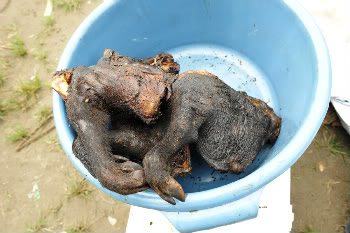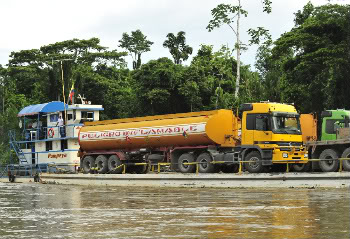Oil company in Ecuador transforms indigenous community into commercial poachers, threatening wildlife in a protected area
The documentary Crude opened this weekend in New York, while the film shows the direct impact of the oil industry on indigenous groups a new study proves that the presence of oil companies can have subtler, but still major impacts, on indigenous groups and the ecosystems in which they live.
In Ecuador’s Yasuni National Park—comprising 982,000 hectares of what the researchers call “one of the most species diverse forests in the world”—the presence of an oil company has disrupted the lives of the Waorani and the Kichwa peoples, and the rich abundance of wildlife living within the forest. By building a 149 kilometer (92 mile) road through the protected forest and providing subsidies to the local tribes, the oil company Maxus Ecuador Inc. transformed some members of the tribes from semi-nomadic subsistence hunters into commercial poachers.
 The collared peccary made up 7.3 percent of the hunted mammals, birds, and reptiles in the study. It’s close relative the white-lipped peccary made up 47.9 percent. Photo by: Julie Larsen Maher © WCS. |
“We’ve found that a road in a forest can bring huge social changes to local groups and the ways in which they utilize wildlife resources,” said Wildlife Conservation Society (WCS) researcher Esteban Suárez, lead author of the study. “Communities existing inside and around the park are changing their customs to a lifestyle of commercial hunting, the first stage in a potential overexploitation of wildlife.”
According to the new study by the WCS and the IDEAS-Universidad San Francisco de Quito in Ecuador, the creation of the single road allowed tribe members to transport game to a market where it is sold illegally. In addition, the subsidies and free access to the road, all provided by the oil company, make the transportation of the meat—and thereby the wild meat market itself—economically viable.
Although sale of wild meat and products in Ecuador is illegal, the researchers report that “local authorities and park rangers know about the market, [but] they lack the resources and political will to stop the illegal trade of wildlife in Pompeya, primarily to avoid conflicts with the local indigenous population.”
 Peccary legs. Wild meat fetched prices double that of domestic in the area. Photo by: Julie Larsen Maher © WCS. |
Some communities of the Waorani tribe even abandoned their traditional semi-nomadic life and built settled villages along the road for easy transport of their game. They took up firearms (instead of the traditional blowguns), which became more prevalent following the arrival of the oil company.
“These changes,” the authors explain, “are amplified by patronizing relationships in which large companies buy their right to operate in the area by providing local communities with resources, money or infrastructure without consideration of the social and ecological impact of these ‘compensation plans'”.
The study published in Animal Conservation found that the wild meat market appeared shortly after the road was constructed in early 1990s and free travel was given to the indigenous tribes. Between 2005 and 2007, 11,000 kilograms (24,000 pounds) of wild meat were sold at the Pompeya market every year. The amount of meat sold every day doubled between 2005 and 2007, from 150 kilograms (330 pounds) to 300 kilograms (661 pounds).
“While the magnitude of the wildlife trade occurring at Pompeya is still limited, its emergence and continuous growth are symptomatic of the dramatic changes that the area is experiencing under the influence of the oil industry and the absence of effective management and control strategies,” the authors write.
 An oil truck on a barge in the Napo River near Yasuni National Park Photo by: Julie Larsen Maher © WCS. |
The most commonly targeted animals for the wild meat harvests were pacas, white-lipped peccaries, collared peccaries, and woolly monkeys. These four species made up 80 percent of the mammal, bird, and reptile meat collected, while fish, primarily caught by the Kichwa, tribe made up 30 percent of all the species’ total.
According to the researchers the availability of cheap travel for the tribes was the largest factor in creating the presence and size of the illegal market, while the demand for wild meat in restaurants spurred on the trade. Sixty-nine percent of the meat was bought by middlemen—who consistently knocked-up the price around 60 percent. These middlemen then transported the meat to restaurants and markets as far away as 234 kilometers (145 miles). Consumers in the area were found to be willing to pay double for wild meat than what they would pay for domestic.
“A simple, seemingly inoffensive road can have far-reaching effects on a landscape and its people,” said Dr. Avecita Chicchón, Director of WCS’s Latin America and Caribbean Program. “It provides hunters with more access to a wider range of forest while providing a low-cost transportation route to markets. More importantly, it plugs communities more easily into the larger economic world while creating increased demand for numerous species of animals. It is the road to unsustainability.”
Citation: E.Suarez, M. Morales, R. Cueva, V. Utreras Bucheli, G. Zapata-Rios, E. Toral, J.Torres, W. Prado & J. Vargas Olalla. Oil industry, wild meat trade and roads: indirect effects of oil extraction activities in a protected area in north-eastern Ecuador. Animal Conservation 12 (2009) 364–373.
Related articles
Amazon tribes have long fought bloody battles against big oil in Ecuador

(09/03/2009) The promotional efforts ahead of the upcoming release of the film Crude have helped raise awareness of the plight of thousands of Ecuadorians who have suffered from environmental damages wrought by oil companies. But while Crude focuses on the relatively recent history of oil development in the Ecuadorean Amazon (specifically the fallout from Texaco’s operations during 1968-1992), conflict between oil companies and indigenous forest dwellers dates back to the 1940s.
Peru to proceed with oil and gas auctions in the Amazon despite indigenous protests
(08/07/2009) Despite violent protests by indigenous groups over plans to expand oil and gas exploration in the Peru’s Amazon rainforest, energy investments in the South American country are expected to increase to $1.5 billion in both 2009 and 2010, reports Reuters.

(08/03/2009) Barely six weeks after a dozen Amazon natives were gunned down by the Peruvian Army in the oil town of Bagua for protesting the cozy relationship between Big Oil and the government of President Alan Garcia, I find myself on the banks of the Mother of God River in Salvacion, Peru, wondering if all those folks died in vain. Any day now, the bulldozers will be moving in as Texas-based Hunt Oil Company – with the full go-ahead of the Peruvian government — fires its first salvo in its assault against the million-acre pristine rainforest wilderness of the little-known and largely unexplored Amarakaeri Communal Reserve.